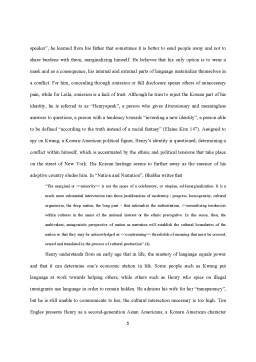Extras din referat
If language is either “a system of communication used by a particular country or community” or “the method of human communication, either spoken or written, consisting of the use of words in a structured and conventional way” (Oxford Dictionary), languaging could be defined as the unique capacity of the human being to change aspects of the world by means of communication. It is particularly this capacity that allows people to acquire and develop a complex system of symbols able to transfer across time and space. Language can be regarded as a medium of communication that represents a constitutive part of culture and mirrors one’s identity, Mumpande arguing that “a community without a language is like a person without a soul” (1). In Chang-Rae Lee’s “Native Speaker”, everyone excepting the main character, Henry Parker, is defined by place, issue that raises the question of defining what we are, the issue of identity, since he equates not space and time, but language and its mastery with identity and still fails to define himself. My aims are to show how in “Native Speaker”, language and its mastery can be associated with identity and to prove that both as a burden and as a sign of trust, communication bears undeniable cultural significance.
In his book “Oneself as Another”, Ricoeur sketches the convergence point between three philosophies. While the first is used to indicate “the immediate positing of the subject, as this is expressed in the first person singular: <<I think>>, <<I am>>” (1), the second distinguishes between two meanings of identity: the “ipse” sense that “implies no assertion concerning some unchanging core of personality” (2) and the “idem” sense that alludes to the dichotomy between the changeable, the variable, and the permanent and the third suggests that “the selfhood of oneself implies otherness to such an intimate degree that one cannot be thought of without the other, that instead one passes into the other” (3). As in his vision all these ideas draw support from suggestions of basic grammar, being thus founded by language, the connection between language and identity becomes obvious in the case of Henry. For immigrants, their use of language clearly is as good an identifier as their style of dressing and physical appearance. Henry’s physical features tell of those coming from the previous country (Korea) and still, he speaks the language as well as any other native-born citizen. It could be speculated that if his American side represents the permanent feature and the Korean side, the changeable one since he misplaces it constantly, that is the reason why he fails to identify himself, but is reflected into his most significant other, his wife.
Preview document
Conținut arhivă zip
- Modes of Languaging Time and Space in Chang-Rae Lee's Native Speaker.docx







